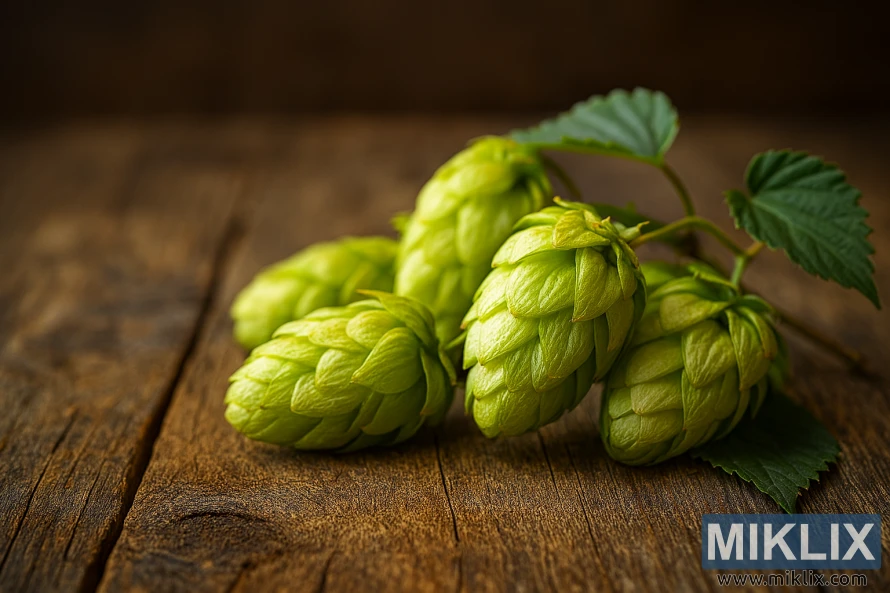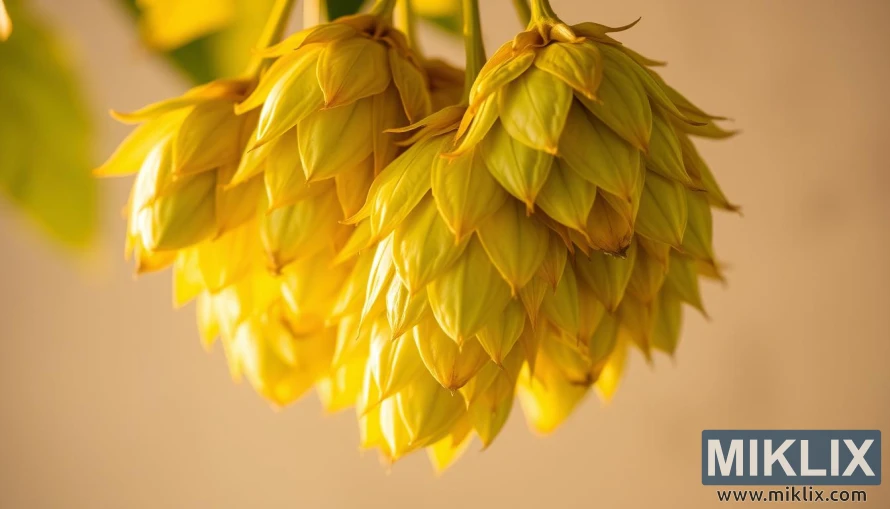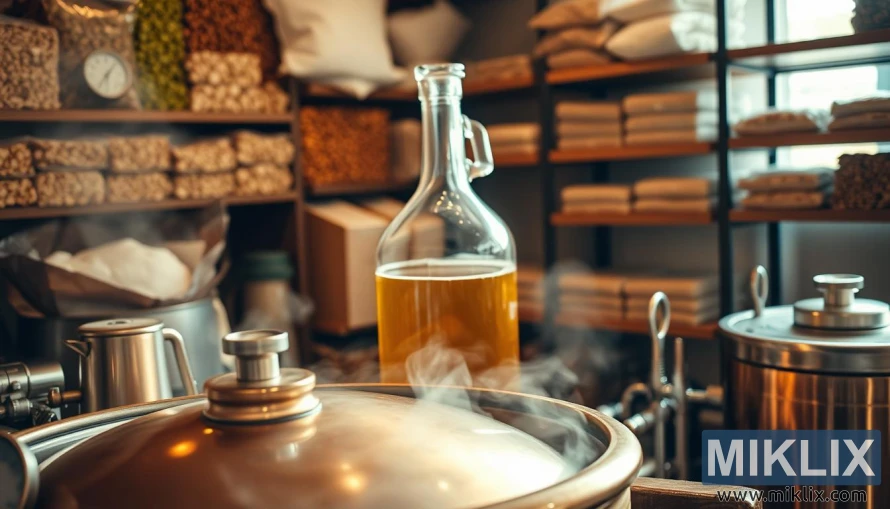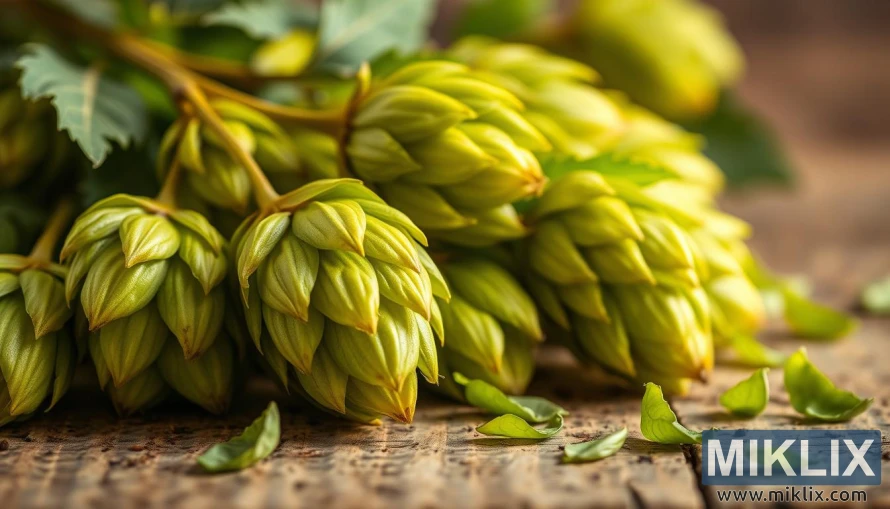Hops in Beer Brewing: First Gold
Published: July 22, 2025 at 9:31:34 PM UTC
Last updated: November 25, 2025 at 2:25:14 PM UTC
First Gold hops are a dual-purpose hop variety from the United Kingdom. They are known for their balanced bittering and aroma properties. Originating from Wye College in England, they were bred from a cross between the Whitbread Golding Variety (WGV) and a dwarf male hop. The unique flavor profile of First Gold hops includes notes of tangerine, orange marmalade, apricot, and herbal undertones. This makes them suitable for a variety of beer styles. Brewers looking to experiment with different flavors find this versatility a key advantage. First Gold is also known as Prima Donna.

Key Takeaways
- First Gold hops offer balanced bittering and aroma properties.
- They are suitable for a variety of beer styles due to their unique flavor profile.
- Originating from the UK, they are a product of Wye College in England.
- Their flavor profile includes notes of tangerine, orange marmalade, and apricot.
- First Gold hops are a dual-purpose hop variety.
- Also known as Prima Donna hops.
Understanding First Gold Hops Origins
In the early 1990s, the English hop breeding program introduced First Gold hops. They were a dwarf variety, known for improved disease resistance and yield. This was part of a larger effort to make hop cultivation easier and more sustainable for farmers.
The English hop breeding program at Wye College played a key role in First Gold hops' development. It aimed to merge the complex flavor and aroma of traditional English hops with the advantages of dwarf growth. These advantages include lower labor costs and better crop management.
First Gold hops are a result of careful selection and breeding. They are valued for their bittering and aroma contributions to beer. The development of such varieties is essential for the brewing industry. It allows for flexibility and consistency in beer production.
The origins of First Gold hops are deeply connected to advancements in hop breeding techniques. By understanding their history and development, brewers can better appreciate their characteristics. This knowledge helps in using them effectively in various beer styles.
Chemical Composition and Properties
For brewers, grasping the chemical makeup of First Gold hops is key. It's vital for achieving the perfect balance of flavor and bitterness in their brews. The specific chemical composition of these hops directly impacts their bittering and aromatic qualities.
First Gold hops boast an alpha acid content that spans from 5.6% to 10%. This high alpha acid level positions them well for bittering in the brewing process. The beta acid content, ranging from 2.3% to 4.1%, also plays a role in the hop's aroma and taste.
The alpha-beta ratio of First Gold hops is a critical consideration for brewers. This ratio affects the beer's overall bitterness and flavor. A higher alpha acid content compared to beta acids means more bittering. A lower ratio, on the other hand, suggests a more balanced contribution to both bitterness and aroma.
- Alpha acids: 5.6% to 10%
- Beta acids: 2.3% to 4.1%
- Alpha-beta ratio: Influences bitterness and flavor
In summary, the chemical composition and properties of First Gold hops make them a versatile choice for brewers. By understanding and utilizing their alpha and beta acid content, brewers can create a variety of beer styles. These styles can have distinct flavor profiles and bitterness levels.
Aroma and Flavor Profile of First Gold Hops
First Gold hops are celebrated for their rich and complex aroma and flavor. They bring a unique mix of citrus, floral, and herbal notes. This blend significantly shapes the beer's character.
The aroma of First Gold hops is a subtle mix of citrus and floral, creating a delicate yet distinct scent. In brewing, these hops add a refined and complex flavor. They also introduce herbal notes that complement the citrus and floral aspects.
First Gold hops are ideal for beers seeking a balanced and refined hop character. Their distinct flavor and aroma enhance the beer's complexity without dominating it.
- Citrus notes add a bright, refreshing quality to the beer.
- Floral elements contribute to a delicate, nuanced aroma.
- Herbal notes provide depth and complexity to the flavor profile.
By using First Gold hops in their recipes, brewers can create a sophisticated and balanced hop character. This elevates the beer's overall characteristics.
Alpha Acid Content and Bittering Capacity
First Gold hops boast an alpha acid content between 5.6% and 10%. This range makes them versatile for various beer styles. The alpha acid content is key in determining the hops' bittering capacity. This is vital for achieving the perfect balance and bitterness in beer.
The bittering capacity of First Gold hops is directly tied to their alpha acid content. This content significantly influences the beer's overall bitterness and flavor. Brewers can use First Gold hops for bittering, flavor, or aroma, depending on the beer's desired characteristics.
For brewers, understanding the alpha acid content and its impact on bitterness is essential. It enables them to make informed decisions about hop usage. This knowledge helps in achieving the desired bitterness level in their beers. First Gold hops, with their moderate to high alpha acid content, are ideal for a wide range of beer styles. This includes everything from pale ales to more bitter brews.
By adjusting the amount and timing of First Gold hop additions, brewers can effectively manage the bittering capacity. This allows them to create beers with complex and balanced flavor profiles.

Best Beer Styles for First Gold Hops
Brewers can explore various beer styles with First Gold hops, thanks to their versatile flavor and aroma. The distinct traits of First Gold hops make them ideal for a range of brewing endeavors.
First Gold hops pair well with both traditional and modern beer styles. They are a favorite among brewers for several reasons. Here are some of the most popular styles that benefit from First Gold hops:
- English Ale: First Gold hops complement the rich, malty flavor of English Ales with their subtle spice and earthy notes.
- Porter: The robust flavor of Porters is balanced by the spicy and woody characteristics of First Gold hops.
- Fruit Beer: First Gold hops can add a unique dimension to Fruit Beers, enriching the fruit flavors with floral and slightly spicy notes.
- Saison: The crisp, refreshing character of Saisons is enhanced by the citrus and floral notes of First Gold hops.
- Blonde Ale: First Gold hops contribute to the light, refreshing taste of Blonde Ales with their subtle hoppy flavor.
The versatility of First Gold hops allows brewers to experiment with different beer styles, achieving a range of flavor profiles. By understanding the characteristics of First Gold hops, brewers can make informed decisions about hop selection to achieve the desired outcomes in their beers.
When choosing a beer style for First Gold hops, brewers should consider the hop's flavor and aroma profile, bittering, and the desired character of the beer. This consideration will help in creating a balanced and complex beer that showcases the qualities of First Gold hops.
Brewing Techniques and Timing
First Gold hops demand precise brewing techniques and timing to fully realize their beer brewing capabilities. The method of using these hops greatly influences the beer's taste, aroma, and bitterness.
The timing of adding First Gold hops is key. For bittering, they are added early in the boil. For flavor and aroma, later additions are better. This approach helps achieve a balanced taste.
Different brewing methods can highlight First Gold hops' characteristics. For instance, dry-hopping enhances their aromatic qualities. Grasping these techniques is essential for crafting top-notch beers.
To fully exploit First Gold hops, brewers should explore various brewing techniques and timing. This experimentation can result in unique and complex beer profiles.
- Early boil additions for bitterness
- Late boil additions for flavor
- Dry-hopping for aroma
By perfecting the brewing techniques and timing for First Gold hops, brewers can create a wide array of beer styles. These beers will showcase the unique qualities of these hops.

First Gold Hops Storage and Handling
Preserving the unique traits of First Gold hops requires careful storage and handling. The quality of these hops can be greatly impacted by temperature, humidity, and packaging. It's essential to manage these factors effectively.
For proper storage, keep First Gold hops in a cool, dry place. It's advisable to use airtight containers or packaging. This protects them from air, light, and moisture. Such measures help maintain their freshness and potency.
Here are some key considerations for storing and handling First Gold hops:
- Store hops in a refrigerator or freezer to maintain a consistent low temperature.
- Use airtight containers or packaging to prevent exposure to air and moisture.
- Keep hops away from direct light, as it can cause degradation.
- Monitor the humidity levels to prevent moisture from affecting the hops.
By adhering to these guidelines, brewers can ensure their First Gold hops retain their desirable characteristics. This includes their aroma and bittering qualities. Proper storage and handling are critical for consistent quality in beer production.
Substitutions and Alternatives
First Gold hops can be swapped with other varieties that share similar traits and flavors. Brewers often turn to hops like Whitbread Golding Variety, East Kent Golding, and Willamette. These hops mirror First Gold in aroma and bittering capabilities.
Whitbread Golding Variety is celebrated for its traditional English hop taste and scent. It's a fitting substitute in many beer recipes. East Kent Golding, another classic, brings a spicy and floral essence. Willamette, an American hop, presents a unique profile but works well as a First Gold substitute in many recipes.
When swapping First Gold hops, brewers must consider the unique traits of the replacement hops. This affects the beer's overall flavor and aroma. This flexibility in hop selection enables brewers to adjust their recipes based on availability, achieving the desired brewing flexibility.
- Whitbread Golding Variety: Traditional English flavor and aroma
- East Kent Golding: Spicy and floral character
- Willamette: Slightly different profile, effective substitute
Common Brewing Challenges and Solutions
Brewers often face hurdles when using First Gold hops, such as achieving the perfect bitterness or flavor. One major issue is inconsistent bitterness. This can stem from variations in alpha acid content.
To tackle this, brewers can adjust the amount of hops used. For example, if the alpha acid content is higher than expected, they can reduce the hop quantity. This helps avoid over-bittering.
Another challenge is getting a consistent flavor profile. First Gold hops offer a complex taste, including fruit and spice notes. But, if not used correctly, they can add unwanted flavors to the beer.
- Monitor the brewing time and temperature to prevent the extraction of undesirable flavors.
- Use the appropriate hop form (pellets, plugs, or whole cones) to achieve the desired flavor profile.
- Adjust the hopping schedule to balance the bitterness and flavor contributions.
By understanding these challenges and implementing the right solutions, brewers can optimize their use of First Gold hops. This improves the overall quality of their beers.
Commercial Examples Using First Gold Hops
Several well-known breweries have incorporated First Gold hops into their recipes, highlighting the hop's unique characteristics. This section explores some of these commercial examples to understand how First Gold hops contribute to the overall character of various beers.
First Gold hops have been utilized in a range of beer styles, from pale ales to porters, showing their versatility. For instance, some breweries use First Gold hops for their balanced alpha acid content. This provides a smooth bitterness without overpowering the other flavors.
- A pale ale brewed with First Gold hops for its floral and slightly sweet flavor profile.
- A porter that utilizes First Gold hops to add depth and complexity to the rich, malty flavor.
- A session ale where First Gold hops contribute to a crisp, refreshing finish.
These examples demonstrate how First Gold hops can be used to achieve different brewing objectives. Whether it's to enhance the aroma, balance the flavor, or add bitterness. By examining these commercial beers, brewers can gain insights into the First Gold hops' full range of possibilities.
The use of First Gold hops in commercial brewing not only showcases their versatility but also highlights the creative possibilities they offer to brewers. As the craft brewing industry continues to evolve, the demand for high-quality hops like First Gold is likely to remain strong.
Recipe Development Guidelines
To craft exceptional beers, brewers must grasp the essence of First Gold hops. They need to understand its flavor, aroma, and bittering capabilities. This knowledge helps in blending it with other ingredients to achieve the perfect beer style.
First Gold hops stand out for their balanced alpha acid content and distinct flavor profile. This versatility makes them ideal for a wide range of beer styles. Brewers should focus on several key aspects when crafting recipes:
- The bittering power of First Gold hops and its role in the beer's overall bitterness.
- The complex flavor and aroma it brings, enriching the beer's character.
- The synergy between First Gold hops and other ingredients, like malts and hops.
By carefully balancing these elements, brewers can highlight First Gold hops' unique qualities. For instance, they might use it as the primary bittering hop. Or, they could add it later to enhance flavor and aroma.
When formulating a recipe, brewers must also adhere to the style guidelines. They need to know the typical characteristics of the style, such as bitterness, flavor, and aroma levels. By combining this knowledge with First Gold hops' attributes, brewers can create recipes that showcase the hops' qualities while staying true to the style.
Successful recipe development with First Gold hops hinges on experimentation and a readiness to refine recipes. By mastering how to use these hops, brewers can explore new avenues in beer creation.
Seasonal Considerations and Availability
Brewers using First Gold hops must be aware of seasonal changes in hop availability. This knowledge is key to planning their brewing schedules effectively. The availability of these hops can vary significantly by season and region. This affects brewers' ability to access them for their recipes.
To manage this variability, brewers should consider several factors:
- Regional hop harvest seasons
- Weather conditions affecting hop crops
- Demand for specific hop varieties
Understanding these factors helps brewers plan their beer production better. For instance, knowing the hop harvest season typically falls in late summer to early fall aids in scheduling brewing activities.
Effective beer planning goes beyond just selecting the right hops. It also involves ensuring their availability. Here are some strategies brewers can use:
- Stockpiling hops during abundant seasons
- Diversifying hop suppliers to mitigate regional shortages
- Adjusting recipes according to hop availability
By adopting these strategies, brewers can reduce the impact of seasonal fluctuations in hop availability. This ensures a consistent supply of First Gold hops for their brewing needs.
Conclusion
First Gold hops stand out in beer brewing, blending bittering and aroma in a unique way. They fit well in a range of beer styles, from classic ales to contemporary lagers. This versatility makes them a valuable addition to any brewer's arsenal.
Exploring the origins, chemical makeup, and brewing uses of First Gold hops can enhance your beer-making skills. Whether you're an experienced brewer or new to the craft, using First Gold hops can take your beers to the next level. It's a great way to stand out in the competitive craft brewing world.
As the craft brewing scene grows, knowing about hops like First Gold is key to making outstanding beers. With their balanced alpha acid levels and nuanced aroma, First Gold hops are perfect for brewers aiming to create complex, refined brews.

Further Reading
If you enjoyed this post, you may also like these suggestions:
